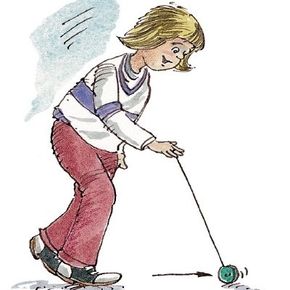Selecting a Yo-Yo
When choosing a yo-yo, it is important to stick to one of the more popular names such as Duncan, Playmaxx, What's Next, Tom Kuhn Custom Yo-Yos, or Yomega.
Beware of cheaply made brands. They are much more difficult to play with. Spend a little extra money and get a better yo-yo.
Advertisement
Non-Sleeping Yo-Yo
A non-sleeping yo-yo can only be used to perform about a half-dozen tricks. It is perfect for beginners. When winding up a non-sleeping yo-yo, put the string on your finger and throw the yo-yo down toward the floor. The yo-yo will unwind as it descends.
When it reaches the end of the string, kinetic energy will keep the yo-yo spinning. Give the string a tug and the yo-yo will wind back up and return to your hand. (This is similar to the Gravity Pull trick.)
Slip-String Yo-Yos
The slip-string yo-yo makes performing a Sleeper possible, which in turn opens up a universe of hundreds of tricks. With a slip-string yo-yo, the string is actually twice as long as it appears to be.
It starts at the finger loop, goes all the way down to the yo-yo, wraps around the axle, and continues on back to the finger. The yo-yo sits in a small string loop around the axle. It is this loop that permits the yo-yo to "sleep" until it either stops spinning or is recalled to the hand with a firm jerk.
Ball-Bearing and Transaxle Yo-Yos
Transaxle yo-yos are designed to spin for an incredibly long time. With a regular yo-yo, the string loops around the axle. With a transaxle yo-yo, a special, extremely low-resistance plastic ring touches the axle.
The string wraps around the outside of the ring, but never touches the axle. This allows for extremely long spins and it also gives the string an extremely long life.
In the late 1980s, Tom Kuhn introduced an improved transaxle, the SB-2, which used a ball-bearing ring around the axle. Spins of 30 to 60 seconds or more are common with ball-bearing yo-yos.
By comparison, a standard wooden-axle yo-yo can be made to sleep only about 10-15 seconds.
Another invention is the Yo-Yo with a Brain, first introduced by Yomega in 1984. The "Brain" Yomega is a plastic yo-yo with a clutch, invented by Mike Caffrey, who would eventually go to work as head of marketing and sales for Duncan.
When the Yomega yo-yo is spinning at full speed, the clutch separates and allows the yo-yo to spin. As the yo-yo slows down, an arrangement of springs inside the yo-yo pushes the clutch halves back together and causes the yo-yo to return to your hand.
The clutch makes it easier for new yo-yoers to learn how to make a yo-yo "sleep."
Even a new yo-yo will require a few adjustments. Learn how to make a slip-knot, adjust tension, and restring in the next section.
